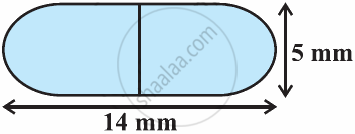Advertisements
Advertisements
Question
The number of solid spheres, each of diameter 6 cm that can be made by melting a solid metal cylinder of height 45 cm and diameter 4 cm, is:
Options
3
5
4
6
Solution
Let r and h be the radius and the height of the cylinder, respectively.
Given:
Diameter of the cylinder = 4 cm
∴ Radius of the cylinder, r = 2 cm
Height of the cylinder, h = 45 cm
Volume of the solid cylinder = `pir^2h=pixx(2)^2xx45 cm^2=180pi cm^3`
Suppose the radius of each sphere be R cm.
Diameter of the sphere = 6 cm
∴ Radius of the sphere, R = 3 cm
Let n be the number of solids formed by melting the solid metallic cylinder.
∴ n × Volume of the solid spheres = Volume of the solid cylinder
`=>nxx4/3 pi R^3=180pi`
`=>nxx4/3 pi(3)^3=180pi`
`=>n=(180xx3)/(4xx27)=5`
Thus, the number of solid spheres that can be formed is 5.
Hence, the correct option is B.
APPEARS IN
RELATED QUESTIONS
2 cubes each of volume 64 cm3 are joined end to end. Find the surface area of the resulting cuboid.
A medicine capsule is in the shape of cylinder with two hemispheres stuck to each of its ends (see the given figure). The length of the entire capsule is 14 mm and the diameter of the capsule is 5 mm. Find its surface area. [Use π = `22/7`]

Prove that the surface area of a sphere is equal to the curved surface area of the circumference cylinder__?
A frustum of a right circular cone has a diameter of base 20 cm, of top 12 cm, and height 3 cm. Find the area of its whole surface and volume.
The largest cone is curved out from one face of solid cube of side 21 cm. Find the volume of the remaining solid.
Two solid cones A and B are placed in a cylindrical tube as shown in fig .16.76. The ratio of their capacities are 2: 1 . Find the heights and capacities of the cones . Also, find the volume of the remaining portion of the cylinder.
A cubical block of side 10 cm is surmounted by a hemisphere. What is the largest diameter that the hemisphere can have? Find the cost of painting the total surface area of the solid so formed, at the rate of ₹5 per 100 sq cm. [Use ππ = 3.14]
How many cubes of 10 cm edge can be put in a cubical box of 1 m edge?
If two solid hemispheres of the same base radius r are joined together along their bases, then curved surface area of this new solid is ______.
Two cones with same base radius 8 cm and height 15 cm are joined together along their bases. Find the surface area of the shape so formed.
